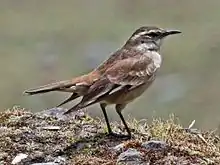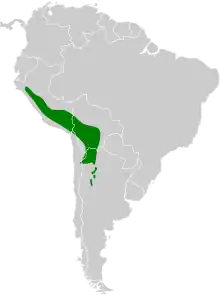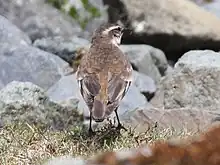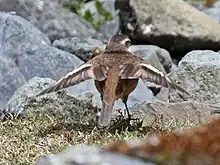| Cream-winged cinclodes | |
|---|---|
 | |
| Scientific classification | |
| Domain: | Eukaryota |
| Kingdom: | Animalia |
| Phylum: | Chordata |
| Class: | Aves |
| Order: | Passeriformes |
| Family: | Furnariidae |
| Genus: | Cinclodes |
| Species: | C. albiventris |
| Binomial name | |
| Cinclodes albiventris | |
 | |
| Synonyms | |
| |
The cream-winged cinclodes (Cinclodes albiventris) is a species of bird in the Furnariinae subfamily of the ovenbird family Furnariidae. It is found in Argentina, Bolivia, Chile, and Peru.[2]
Taxonomy and systematics
The cream-winged cinclodes was previously considered conspecific with what was then called the bar-winged cinclodes (C. fuscus sensu lato). In a three-way split of the bar-winged that began in about 2009, the cream-winged cinclodes was recognized as a full species. C. fuscus was renamed to the present buff-winged cinclodes to avoid confusion with the previous much more complex species.[3][4][5]
The cream-winged cinclodes has these five subspecies:[2]
- C. a. albiventris (Philippi & Landbeck, 1861)
- C. a. tucumanus Chapman, 1919
- C. a. riojanus Nores, 1986
- C. a. rufus Nores, 1986
- C. a. yzurietae Nores, 1986

Description
The cream-winged cinclodes is 15 to 19 cm (5.9 to 7.5 in) long and weighs about 20 to 34 g (0.71 to 1.2 oz). It is a small cinclodes with a shortish bill. The sexes have the same plumage. Adults of the nominate subspecies C. a. albiventris have a distinct light buffish white supercilium, dark gray-brown ear coverts with pale streaks, and a white malar area. Their crown and upperparts are rusty-gray. Their wing coverts are dark brown with wide buffish edges and their flight feathers dark fuscous with a cream band across them. Their tail's central feathers are dark brown and the rest blackish brown; the outer three pairs have progressively more milky-buff tips. Their entire underparts are whitish. Their iris is brown or dark brown, their bill dark brown to blackish whose mandible often has a paler base, and their legs and feet blackish to dark brownish.[6][7]
Subspecies C. a. yzurietae has darker brown crown and upperparts and a much whiter breast than the nominate. C. a. rufus has more rufescent upperparts, richer brown wings and tail, a more ochraceous belly, and more rufescent flanks than the nominate. C. a. riojanus has darker chocolate-brown upperparts and a browner breast than all the other subspecies. C. a. tucumanus has a deep buff wingband and a more reddish back and paler underparts than riojanus.[6][7]
Distribution and habitat
The nominate subspecies of the cream-winged cinclodes is by far the most widespread. It is found in the Andes from northern Peru south through western Bolivia and northern Chile into northwestern Argentina as far as La Rioja Province. C. a. tucumanus is found in Argentina's Tucumán Province. C. a. riojanus is found in the Sierra de Famatina in La Rioja. C. a. rufus is found in northwestern Argentina, in the Campo de Arenal area of Catamarca Province. C. a. yzurietae is also found in Catamarca, in the Sierra del Manchao.[6]
The cream-winged cinclodes inhabits a variety of open habitats, most of them grassy such as páramo and puna grassland, nearby agricultural fields, and also arid montane scrublands. It usually is found near water, especially bogs and streams, and is commonly seen around human habitations. In elevation it occurs between 2,500 and 5,000 m (8,200 and 16,400 ft) in Chile, mostly between 2,750 and 4,800 m (9,000 and 15,700 ft) in Peru, and usually above 2,100 m (6,900 ft) in Argentina.[6][7]
Behavior
Movement
The cream-winged cinclodes is mostly a year-round resident throughout its range, though some individuals move to lower elevations in winter, during periods of bad weather, or when favored feeding areas dry up.[6]
Feeding
The cream-winged cinclodes feeds on a variety of invertebrates including many insects and also seeds. It forages singly and in pairs while hopping and running on the ground. It probes and gleans from wet and dry ground, rocks, grass, dung, and shallow water.[6]

Breeding
The cream-winged cinclodes breeds in the austral spring and summer. It is monogamous. Males sing and make a wing-flapping display from a perch. The species nests in a burrow at the end of a tunnel it excavates in an earth bank; it probably also nests in holes in a human structure's wall. It floors the nest chamber with grass and hair. The clutch size is two eggs. The incubation period, time to fledging, and details of parental care are not known. It is suspected to occasionally fledge two broods in a season.[6]
Vocalization
The cream-winged cinclodes' song has been rendered as "cheet, cheet, cheet, prre EEEEOOOO, OOOOEEEEEE’cheet’ cheet’cheet...", though in Chile it has been described as "a rising twittery trill, 'trrrreee’i’i’i’i’i' ".[6] Its calls are thought to be similar to those of the buff-winged cinclodes, which are "a sharp 'pfip'...[a] series of high-pitched tinkling notes [and in flight] a sharp whistled 'tsip' ".[6][8]
Status
The IUCN has assessed the cream-winged cinclodes as being of Least Concern. It has a large range. Its population size is not known but is believed to be stable. No immediate threats have been identified.[1] It is considered widespread and common in most of its range, and in some areas is the most common cinclodes. In much of its range "its habitats are subject to, at most, only minimal anthropogenic disturbance; probably benefits from effects of grazing".[6]
References
- 1 2 BirdLife International (2017). "Cream-winged Cinclodes Cinclodes albiventris". IUCN Red List of Threatened Species. 2017: e.T22736220A111157293. doi:10.2305/IUCN.UK.2017-1.RLTS.T22736220A111157293.en. Retrieved 3 September 2023.
- 1 2 Gill, Frank; Donsker, David; Rasmussen, Pamela, eds. (July 2023). "Ovenbirds, woodcreepers". IOC World Bird List. v 13.2. Retrieved July 31, 2023.
- ↑ Remsen, J. V., Jr., J. I. Areta, E. Bonaccorso, S. Claramunt, G. Del-Rio, A. Jaramillo, D. F. Lane, M. B. Robbins, F. G. Stiles, and K. J. Zimmer. Version 31 May 2023. A classification of the bird species of South America. American Ornithological Society. https://www.museum.lsu.edu/~Remsen/SACCBaseline.htm retrieved May 31, 2023
- ↑ Derryberry, E.P., S. Claramunt, G. Derryberry, R.T. Chesser, J. Cracraft, A. Aleixo, J. P rez-Em n, J.V. Remsen, Jr., and R. T. Brumfield. 2011. Lineage diversification and morphological evolution in a large-scale continental radiation: the Neotropical ovenbirds and woodcreepers (Aves: Furnariidae). Evolution 65: 2973 2986.
- ↑ Sanín, Camilo (August 2009). "Proposal (415) to South American Classification Committee: Split Cinclodes fuscus into three species". South American Classification Committee of the American Ornithological Society. Retrieved September 3, 2023.
- 1 2 3 4 5 6 7 8 9 10 del Hoyo, J., N. Collar, and G. M. Kirwan (2020). Cream-winged Cinclodes (Cinclodes albiventris), version 1.0. In Birds of the World (J. del Hoyo, A. Elliott, J. Sargatal, D. A. Christie, and E. de Juana, Editors). Cornell Lab of Ornithology, Ithaca, NY, USA. https://doi.org/10.2173/bow.crwcin1.01 retrieved September 3, 2023
- 1 2 3 de la Peña, Martín R.; Rumboll, Maurice (2001). Birds of Southern South America and Antarctica. Princeton Illustrated Checklists. New Jersey: Princeton University Press. pp. Plate 61. ISBN 0691090351.
- ↑ Remsen, Jr., J. V. and G. M. Kirwan (2020). Buff-winged Cinclodes (Cinclodes fuscus), version 1.0. In Birds of the World (J. del Hoyo, A. Elliott, J. Sargatal, D. A. Christie, and E. de Juana, Editors). Cornell Lab of Ornithology, Ithaca, NY, USA. https://doi.org/10.2173/bow.buwcin1.01 retrieved September 3, 2023
